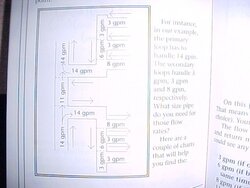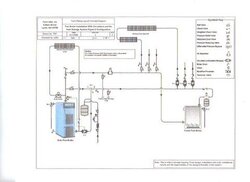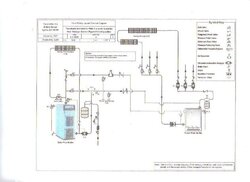Pressurized Storage Piping Idea
- Thread starter chuck172
- Start date
-
Active since 1995, Hearth.com is THE place on the internet for free information and advice about wood stoves, pellet stoves and other energy saving equipment.
We strive to provide opinions, articles, discussions and history related to Hearth Products and in a more general sense, energy issues.
We promote the EFFICIENT, RESPONSIBLE, CLEAN and SAFE use of all fuels, whether renewable or fossil.
You are using an out of date browser. It may not display this or other websites correctly.
You should upgrade or use an alternative browser.
You should upgrade or use an alternative browser.
- Status
- Not open for further replies.
WoodNotOil
Minister of Fire
Bob Rohr
Minister of Fire
Ok, I get the part about maintaining the oil boiler temperature for DHW at all time. I don't like it but I understand the need to do that.
The wood boiler goes out, the tank is at 180, it has heat to give to the heating system.
A zone pump calls on, P2 must call on also, correct? As it is the only way to move, or steal heat from the tank. As there is no means to move that energy with just zone pumps running.
Tank temperature is keeping the oil boiler hot enough for any DHW use.
The loop, or boiler drops to 160F? and it must fire to maintain DHW, right?
So now the oil boiler will be charging the buffer as it handles loads? Or does P2 drop out and only the zone pump moves flow through the fired boiler, being the oil one.
What is the flow rate through the boiler with just zone 1 running for example? If all 3 zones and the buffer are loading can the oil boiler drop to below condensing mode and soot up? what prevents cold return to the boiler as you have the wood one protected?
How many gpm or btus flow from the buffer under various loads?
That is my point about primary secondary, I can calculate exactly what happens, why, and even adjust flow rates based on system requirements and boiler required flow rates. By taking off your connections via closely spaced tees you have control.
To me piping that drawing just has flow rates and heat movement floating in limbo. I think it is inefficient piping if it can't do exactly want you want and when. Sure it may work, and may work well. But can you tell me how or why?
I like to be able to disconnect the boiler (s) from the buffer. I don't see how you can do that. I'd like to know under any combination of heat loads that they get adequate flow and the boiler has proper flow.
You comment about "steals some heat from the tank" is my quandry.
Reminds me of the Jennifer Antison movie. Her boyfriend is about to move millions from his companies account into his own via a computer program. He explains he is not really stealing the money. The money will just BECOME ours :0
Here is a picture from Dan Holohan's "Pumping Away" book on primary secondary piping. It explains the how and whys of flow via primary secondary closely spaced tees. You can define flow rates and even temperatures coming and going from every portion of the piping.
hr
The wood boiler goes out, the tank is at 180, it has heat to give to the heating system.
A zone pump calls on, P2 must call on also, correct? As it is the only way to move, or steal heat from the tank. As there is no means to move that energy with just zone pumps running.
Tank temperature is keeping the oil boiler hot enough for any DHW use.
The loop, or boiler drops to 160F? and it must fire to maintain DHW, right?
So now the oil boiler will be charging the buffer as it handles loads? Or does P2 drop out and only the zone pump moves flow through the fired boiler, being the oil one.
What is the flow rate through the boiler with just zone 1 running for example? If all 3 zones and the buffer are loading can the oil boiler drop to below condensing mode and soot up? what prevents cold return to the boiler as you have the wood one protected?
How many gpm or btus flow from the buffer under various loads?
That is my point about primary secondary, I can calculate exactly what happens, why, and even adjust flow rates based on system requirements and boiler required flow rates. By taking off your connections via closely spaced tees you have control.
To me piping that drawing just has flow rates and heat movement floating in limbo. I think it is inefficient piping if it can't do exactly want you want and when. Sure it may work, and may work well. But can you tell me how or why?
I like to be able to disconnect the boiler (s) from the buffer. I don't see how you can do that. I'd like to know under any combination of heat loads that they get adequate flow and the boiler has proper flow.
You comment about "steals some heat from the tank" is my quandry.
Reminds me of the Jennifer Antison movie. Her boyfriend is about to move millions from his companies account into his own via a computer program. He explains he is not really stealing the money. The money will just BECOME ours :0
Here is a picture from Dan Holohan's "Pumping Away" book on primary secondary piping. It explains the how and whys of flow via primary secondary closely spaced tees. You can define flow rates and even temperatures coming and going from every portion of the piping.
hr
Attachments
WoodNotOil
Minister of Fire
Master of Sparks - I fully respect and agree with you that primary/secondary is the better way to go if you are starting from scratch. However, some of us have to start with what we have.
When a zone calls for heat P2 does not automatically run. There would need to be an aquastat, probably on the exit pipe of the oil boiler, that tells P2 to run when the oil boiler needs heat. The differential should not be too low on zone return temps to prevent the water circulating from the tank to heat the oil boiler.
The tank to oil boiler piping in my diagram is just a copy of the tarm to oil boiler conection. On my system this works fine even with a 007 circ moving the water between boilers. This even works if all zones are calling for heat, which has happened. So I would assume this should work
"You comment about “steals some heat from the tank” is my quandry."
All I mean by this is that the flow will be split between the zone(s) calling for heat and the flow to charge the tank. This water will be up to temp because it is coming from the tarm.
I agree that a straight forward piping that can be measured and predicted is ideal. However, I think storage, both pressurized and non-pressurized, can be successfully implimented with series/parallel systems.
When a zone calls for heat P2 does not automatically run. There would need to be an aquastat, probably on the exit pipe of the oil boiler, that tells P2 to run when the oil boiler needs heat. The differential should not be too low on zone return temps to prevent the water circulating from the tank to heat the oil boiler.
The tank to oil boiler piping in my diagram is just a copy of the tarm to oil boiler conection. On my system this works fine even with a 007 circ moving the water between boilers. This even works if all zones are calling for heat, which has happened. So I would assume this should work
"You comment about “steals some heat from the tank” is my quandry."
All I mean by this is that the flow will be split between the zone(s) calling for heat and the flow to charge the tank. This water will be up to temp because it is coming from the tarm.
I agree that a straight forward piping that can be measured and predicted is ideal. However, I think storage, both pressurized and non-pressurized, can be successfully implimented with series/parallel systems.
To my defense, I was told by the Tarm techs. to tie into the oil boiler by just cutting in 1 1/4 tees to the supply and return header.
I roughed in all my piping and ran a new zone of baseboard in my basement while waiting delivery of my wood boiler.
The two attachments included here are: #1 Tarm drwg. #2 close to what my tie-ins look like.
It will take quite a lot of work to change my existing piping around to primary/secondary. I think I found a way to do it and its the right time of the year.
What a "conundrum" (hows that one woodnotoil)
I roughed in all my piping and ran a new zone of baseboard in my basement while waiting delivery of my wood boiler.
The two attachments included here are: #1 Tarm drwg. #2 close to what my tie-ins look like.
It will take quite a lot of work to change my existing piping around to primary/secondary. I think I found a way to do it and its the right time of the year.
What a "conundrum" (hows that one woodnotoil)
Attachments
Bob Rohr
Minister of Fire
WoodNotOil said:Master of Sparks - I fully respect and agree with you that primary/secondary is the better way to go if you are starting from scratch. However, some of us have to start with what we have.
When a zone calls for heat P2 does not automatically run. There would need to be an aquastat, probably on the exit pipe of the oil boiler, that tells P2 to run when the oil boiler needs heat. The differential should not be too low on zone return temps to prevent the water circulating from the tank to heat the oil boiler.
The tank to oil boiler piping in my diagram is just a copy of the tarm to oil boiler conection. On my system this works fine even with a 007 circ moving the water between boilers. This even works if all zones are calling for heat, which has happened. So I would assume this should work
"You comment about “steals some heat from the tank” is my quandry."
All I mean by this is that the flow will be split between the zone(s) calling for heat and the flow to charge the tank. This water will be up to temp because it is coming from the tarm.
I agree that a straight forward piping that can be measured and predicted is ideal. However, I think storage, both pressurized and non-pressurized, can be successfully implimented with series/parallel systems.
I think, without P2 running, with a zone calling for heat, the blue line is the flow path. So there is no "incentive" for flow from the buffer. Maybe the aquastat should measure the buffer temperature, not the boiler outlet? that way you would use the buffer to the lowest possible temperature. but again the tankless coil in the oil boiler for DHW limits how low you could draw down the buffer temperature.
A thought on efficiencies. I think there are a number of different efficiencies at work in these systems.
Combustion efficiency, how well the boiler turns the chemical energy stored in the cord wood to thermal energy. This is what draws me to gasification units. Currently that looks to be the best technology to get mid 80%. A combustion analyzer might be the tool to check that.
Then the boiler HX efficiency. How well does the design of the boiler transfer the energy from the fire to the water jacket. Stack temperature, a BTU meter could help determine that.
Then the piping or transmission efficiency. Pipe size, circ size, insulated piping and components, etc. The pipe should be sized to handle the flow with a 3.2 to 4 fps flow at the required gpm rate.
The circ should be sized to move that load with the least amount of electrical consumption. Keeping high pressure drop components out of the system helps, like 3 way thermostatic valves.
Distribution efficiency to the space. An example might be the use of transfer plates in radiant applications instead of staple up tube. The ability to transfer all the energy from the water flow, through the tube wall to the floor and into the space. I'd include insulation in this category, either the foam used under slab radiant or the insulation used under staple up applications. assure the heat is going where you want it with the least amount of loss to the ground or room below.
The biggest, and easiest to "tweak" efficiency would be the building or structure. Limit the heat loss from the building as much as possible BEFORE you design the heating, or cooling system. You'd be surprised what a few tubes of caulk and some weatherstrip upgrades can do to building infiltration.
I like chasing all those numbers. It is a never ending challange as technology continues to improve. Spray foam insulation, gasification boilers, mod con boilers, weather responsive controls, ECM circ pumps, etc. these are all products that have come along since I built my last home.
That is what keeps this business so fun and interesting for me. The next 10 years may be the golden years with fuel prices going crazy. i've seen figures on how much electrical energy could be saved if every refrigerator used ECM motors. consider millions of coke machines and refrigerated cases in grocery markets, etc.
Any ways, back to my solar project in the shop.
hr
WoodNotOil
Minister of Fire
hr - Thanks for the thoughtful comments. I am an amatuer and you are clearly in the profession. I agree with you entirely on efficiency. Assuming chuck has all the other areas covered, I was simply trying to give him an option for keeping the series/parallel setup and adding storage. I still think it would work, but it would be less efficient for sure.
Chuck - Since you don't have a DHW coil it is probably best to go to P/S piping. It would not be that difficult. Add a couple of tee's and ball valves and connect the tarm hot to the the heating loop and the loops return to the tarm return. Then using ball valves shut off the parallel flow through the oil boiler. That way the loop can be fed by the tarm or the oil boiler. Once you get a full design worked up it would probably require at leat one more check valve. Then follow nofossil's sticky from there. However, it would work the other way and storage in itself adds a creat deal of efficiency. It is ultimitely your call.
Chuck - Since you don't have a DHW coil it is probably best to go to P/S piping. It would not be that difficult. Add a couple of tee's and ball valves and connect the tarm hot to the the heating loop and the loops return to the tarm return. Then using ball valves shut off the parallel flow through the oil boiler. That way the loop can be fed by the tarm or the oil boiler. Once you get a full design worked up it would probably require at leat one more check valve. Then follow nofossil's sticky from there. However, it would work the other way and storage in itself adds a creat deal of efficiency. It is ultimitely your call.
WoodNotOil, Yes you're right, P/S is the way for me to go. MasterOfSparks references "Modern Hydronic Heating by John Sigenthaler P.E." I looked up a few of his articles and he has one in particular that deals with wood boilers.
http://www.pmmag.com/Articles/Column/ac719ac235fc7010VgnVCM100000f932a8c0____
A quote:
First and foremost, do not create a system that moves heat produced by one boiler through the other. To do so just makes the cooler boiler a heat dissipater. Series piping is not an option. Even with parallel or primary/secondary piping, it’s imperative that system controls have the intelligence to take a non-operational (or lukewarm) boiler “off-line.”
Can't get clearer than that.
I have a lot of alterations to do, but it's a good time of the year to do it. It's just too bad the price of copper is outrageous right now.
http://www.pmmag.com/Articles/Column/ac719ac235fc7010VgnVCM100000f932a8c0____
A quote:
First and foremost, do not create a system that moves heat produced by one boiler through the other. To do so just makes the cooler boiler a heat dissipater. Series piping is not an option. Even with parallel or primary/secondary piping, it’s imperative that system controls have the intelligence to take a non-operational (or lukewarm) boiler “off-line.”
Can't get clearer than that.
I have a lot of alterations to do, but it's a good time of the year to do it. It's just too bad the price of copper is outrageous right now.
- Status
- Not open for further replies.
Similar threads
- Replies
- 9
- Views
- 2K
- Replies
- 0
- Views
- 943
- Replies
- 8
- Views
- 598
- Replies
- 10
- Views
- 2K




